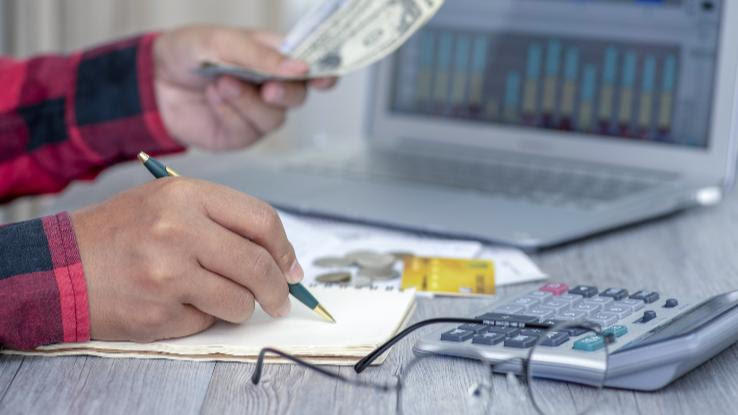
When it comes to personal finances, it’s no secret that stashing away cash for an emergency is always a good idea. An old rule of thumb says that you should save up at least three months’ worth of living expenses just in case the unexpected should strike. And, experts now say it’s better to keep enough to cover six months’ worth of living expenses on hand so you’re even more thoroughly prepared for a potential financial downturn.
But where should you put that extra money you’re saving for emergencies — or the money you’re setting aside for other financial goals? A high-yield savings account can be a solid choice that helps you earn while you save. To decide if this option is right for your needs, take a look at this overview of what a high-yield savings account is and how it differs from traditional savings accounts.
What’s a High-Yield Savings Account?

In many ways, high-yield savings accounts are similar to traditional savings accounts. They’re bank accounts where you can safely store money you don’t need to spend right away and allow those funds to earn interest. What sets high-yield accounts apart, however, is that you’ll earn more money faster when it comes to interest. “High yield” means there’s larger income returned on your investment — which, in this case, is simply the money you’ve deposited into the account.
According to the FDIC, the average annual return for a traditional savings account is around 0.06%. With a high-yield savings account, however, you can expect to earn an interest rate that’s anywhere from 10 to 25 times higher. While the return on even the highest-yield savings account is still unlikely to make you a millionaire, it’s better to take advantage of as high an interest rate as you possibly can and earn more over time than you would with a traditional savings account.
How Do High-Yield Savings Accounts Work?

One helpful thing about high-yield savings accounts is that these types of accounts work just like their traditional counterparts. While some require minimum deposits, there are now plenty that don’t. You’ll simply open the account just like you would a regular savings account and then begin making deposits.
Up until a few decades ago, most people opened savings accounts at the same banks where they had checking accounts. Due to the rise of online banking, however, it’s now much easier to be pickier about savings account interest rates. While it used to be a bit of a hassle to have accounts open at different financial institutions, it’s now far easier to link and transfer money effortlessly between accounts online. Keep this in mind when you start researching banks where you might open your high-yield account.
What Are the Pros and Cons of High-Yield Savings Accounts?

If you’re looking for a stress-free place to stash your money, a high-yield savings account may be for you. They’re a great place to build a nest egg or even save up money you’ll put towards the down payment on a particular purchase, such as a house or car. Ultimately, whether or not it’s worth opening one will depend on your financial goals. Here are some pros and cons to help put things in perspective.
Pros
- While “high yield” may mean you could enjoy an interest rate of 1% — not a huge amount when you consider the interest rates you might pay on loans or credit cards _ the interest you’ll earn on a high-yield savings account is still a lot better than the low returns traditional savings accounts offer.
- As long as you open your account through an FDIC-insured institution, it’ll be automatically insured up to $250,000. Even if the bank were to go under, your money up to that amount would still be safe.
- Many high-yield savings accounts offer compounding interest, which means that you earn interest on earlier interest the bank paid you.
- You can withdraw your money at any time. Unlike many government bonds or certificates of deposit (CDs), high-yield savings accounts don’t require your to commit to leaving your money untouched for a certain amount of time.
Cons
- Even though a high-yield savings account is one of the safest investments you can make, it’s not among those that offer substantial gains. While a 1% interest rate may be impressive when it comes to savings accounts, you’ll earn more money over time by investing in bonds, CDs or even your retirement account.
- Interest rates can fluctuate over time, so your rate of return can decline over time — but it can also increase.
- Many high-yield savings accounts are available through online banks that may not actually have physical locations. Make sure you look into ATMs you can withdraw cash from without paying fees before signing up.
- Like all savings accounts, there are limits to the number of withdrawals you can make per month without incurring fees.
How to Open a High-Yield Savings Account

One of the most important elements of opening a new savings account is figuring out which one is right for you. As mentioned, many of the financial institutions that offer the highest yields exist completely online.
The good news is that this makes it easy to compare rates and even open your account right from your computer. Alternatively, you may be able to find a brick-and-mortar bank or credit union that offers high-yield savings accounts. In that case, you can generally either open one in person or online if you prefer.
While you’ll want to look for a great interest rate, there are a few other things to check on before opting for what looks like a great offer. When making your comparisons, look into things like:
- Whether the interest rate is compounded and if so, how often it compounds
- Where the nearest free ATMs are that you’ll be able to access without paying fees
- If the account requires a minimum balance
- If there are any maintenance fees associated with the account — these are relatively uncommon, especially when it comes to online savings accounts, but it’s better to do your research than to find out after you end up owing them
The Bottom Line on High-Yield Savings

In general, a high-yield savings account is a great way to maximize your return when it comes to saving up personal emergency funds or saving for a vacation or other large purchase. As long as you choose an FDIC-insured account, it should be a safe and liquid way to store your money until you need it.
Keep in mind that even a high-yield savings account shouldn’t be the end-all of your financial strategy. Most customers use them as a risk-free part of an overall portfolio that also includes things like stocks, bonds and other investments. Although they may not have an impressively high return, high-yield savings accounts can give you a substantially higher return over time than a traditional savings account. And, their risk-free nature means you don’t have to worry about disasters such as a stock market crash that could otherwise drastically alter your funds overnight.





